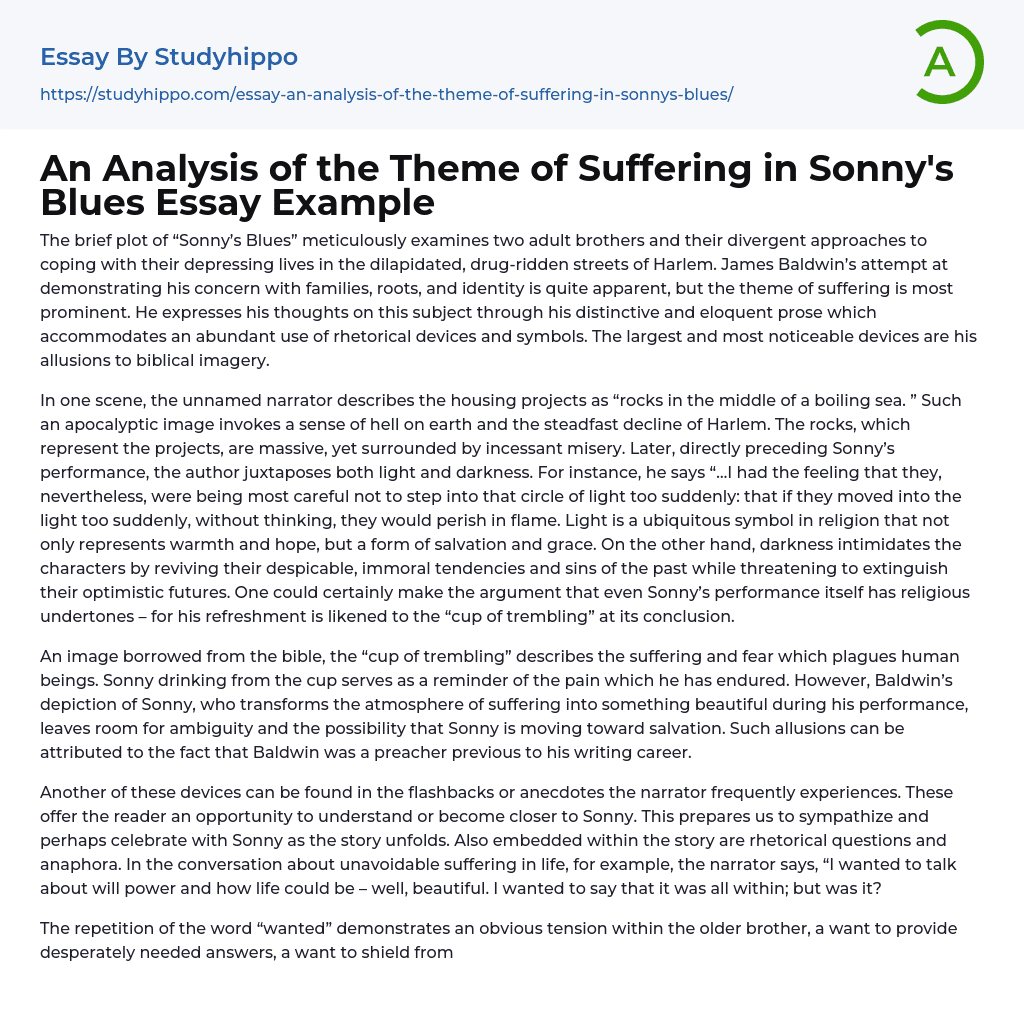

An Analysis of the Theme of Suffering in Sonny’s Blues Essay Example
The brief plot of “Sonny’s Blues” meticulously examines two adult brothers and their divergent approaches to coping with their depressing lives in the dilapidated, drug-ridden streets of Harlem. James Baldwin’s attempt at demonstrating his concern with families, roots, and identity is quite apparent, but the theme of suffering is most prominent. He expresses his thoughts on this subject through his distinctive and eloquent prose which accommodates an abundant use of rhetorical devices and symbols. The largest and most noticeable devices are his allusions to biblical imagery.
In one scene, the unnamed narrator describes the housing projects as “rocks in the middle of a boiling sea. ” Such an apocalyptic image invokes a sense of hell on earth and the steadfast decline of Harlem. The rocks, which represent the projects, are massive, yet surrounded by incessant misery. Later,
...directly preceding Sonny’s performance, the author juxtaposes both light and darkness. For instance, he says “…I had the feeling that they, nevertheless, were being most careful not to step into that circle of light too suddenly: that if they moved into the light too suddenly, without thinking, they would perish in flame. Light is a ubiquitous symbol in religion that not only represents warmth and hope, but a form of salvation and grace. On the other hand, darkness intimidates the characters by reviving their despicable, immoral tendencies and sins of the past while threatening to extinguish their optimistic futures. One could certainly make the argument that even Sonny’s performance itself has religious undertones – for his refreshment is likened to the “cup of trembling” at its conclusion.
An image borrowed from the bible, the “cup of trembling” describes the sufferin
and fear which plagues human beings. Sonny drinking from the cup serves as a reminder of the pain which he has endured. However, Baldwin’s depiction of Sonny, who transforms the atmosphere of suffering into something beautiful during his performance, leaves room for ambiguity and the possibility that Sonny is moving toward salvation. Such allusions can be attributed to the fact that Baldwin was a preacher previous to his writing career.
Another of these devices can be found in the flashbacks or anecdotes the narrator frequently experiences. These offer the reader an opportunity to understand or become closer to Sonny. This prepares us to sympathize and perhaps celebrate with Sonny as the story unfolds. Also embedded within the story are rhetorical questions and anaphora. In the conversation about unavoidable suffering in life, for example, the narrator says, “I wanted to talk about will power and how life could be – well, beautiful. I wanted to say that it was all within; but was it?
The repetition of the word “wanted” demonstrates an obvious tension within the older brother, a want to provide desperately needed answers, a want to shield from his sibling the true bitterness and unforgiving nature of life. The fact that they appear in rhetorical questions further develops the clear guilt the narrator feels. One final, yet very loosely defined and very vital “rhetorical device,” which I feel has been utterly overlooked by many, is the purposeful act of failing to give the narrator a name. Baldwin’s doing so forces us, practically against our will, to become best friends, so to speak, with Sonny.
It causes us to subconsciously overlook the narrator, despite his significant role, and
take pity in the plight of Sonny -- the true bearer and depiction of suffering in this work. This device is in many cases the first thing we recognize, yet the first thing to leave us when we take into account the characterization of Sonny. One rarely tends to think about the kind of effort an author puts into his/her work as you read, but if one ever really chooses to reflect on that, this would be the perfect piece to observe.
Sure, it is a short read with a seemingly simple design. But to leave it at that is to fail to acknowledge the brilliant symbolism and rhetorical devices that are utilized vivaciously to create morally and emotionally complex characters. Each is geared toward evoking a sense of suffering or sensitivity for those who suffer, each achieves its purpose within the text, and together they construct a realistic world on paper. This is a skill which is tremendously difficult to accomplish and is characteristic of only those that have mastered their craft.
- Book Summary essays
- Metaphor essays
- Reader essays
- Rhyme essays
- Literary devices essays
- Villain essays
- Books essays
- Genre essays
- Literary Criticism essays
- Writer essays
- Protagonist essays
- Simile essays
- Poem essays
- Book Report essays
- Book Review essays
- Greek Mythology essays
- Plot essays
- Tragic Hero essays
- Coming of Age essays
- Play essays
- Rhetoric essays
- Rhetorical Question essays
- Translation essays
- Understanding essays
- Reason essays
- Character essays
- Letter essays
- American Literature essays
- Literature Review essays
- Utopia essays
- Poetry Analysis essays
- Dante's Inferno essays
- Between The World and Me essays
- Incidents in The Life of a Slave Girl essays
- Flowers for Algernon essays
- Myth essays
- Everyday Use essays
- Boo Radley essays
- Genesis essays
- Richard iii essays
- Alice in Wonderland essays
- On the road essays
- Ozymandias essays
- The Nightingale essays
- Holden Caulfield essays
- Animal Farm essays
- 1984 essays
- A Hanging essays
- Shooting An Elephant essays
- A Tale Of Two Cities essays



